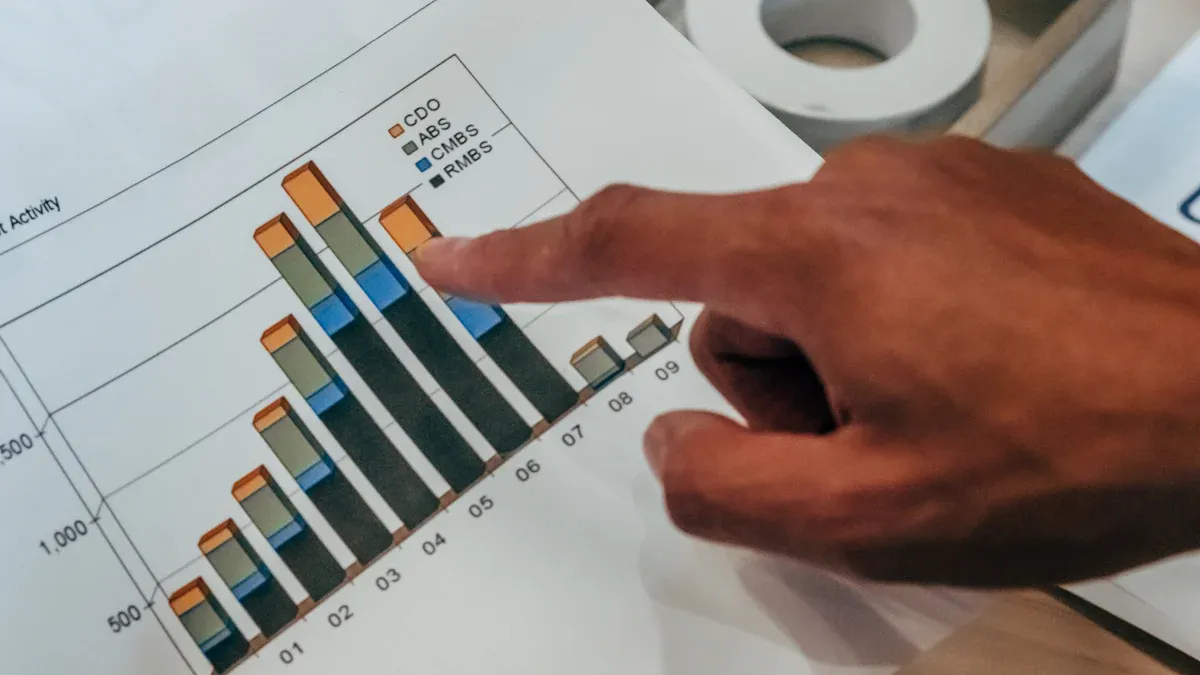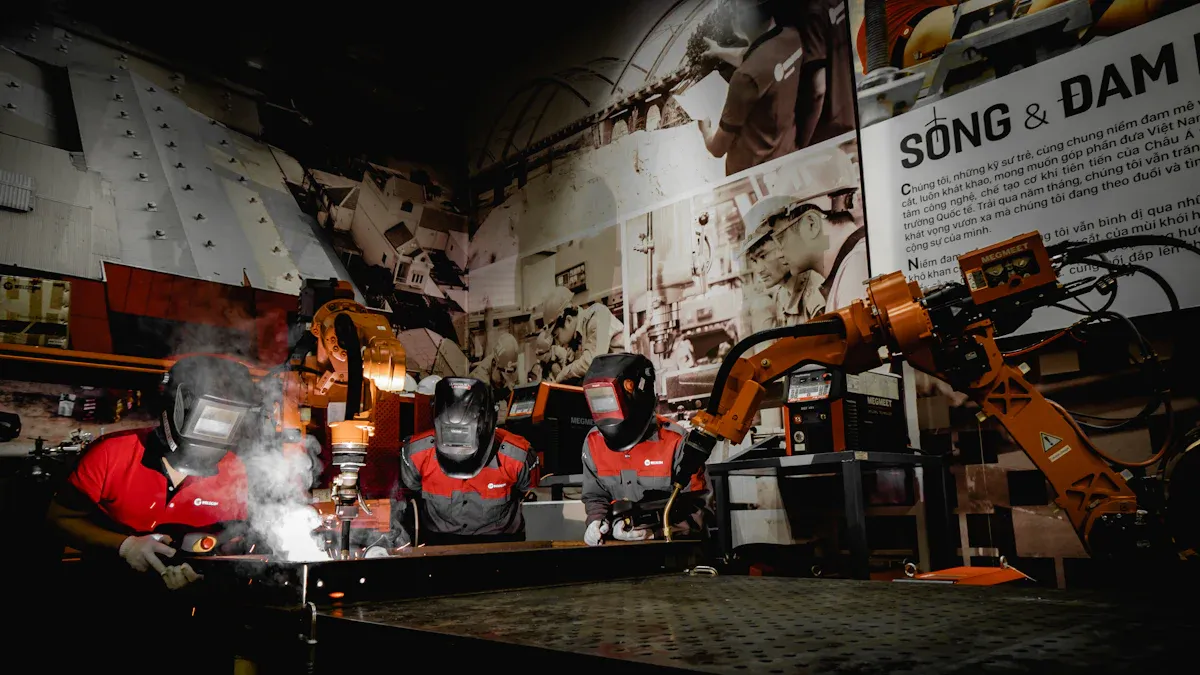
Predictive analytics offers a powerful solution to the fast fashion industry’s core challenge of balancing supply with demand. The industry generates a staggering 92 million tonnes of textile waste annually. This data-driven approach helps brands forecast consumer trends with high accuracy. It minimizes overproduction and prevents costly stockouts, tackling the estimated $70 billion to $140 billion in excess inventory. This shift supports a move toward sustainable fashion, making predictive analytics essential for a future of sustainable fashion.
In an industry defined by speed and waste, predictive analytics offers a clear path to both profitability and sustainability.
Using Predictive Analytics for Trend Forecasting

Predictive analytics transforms how fashion brands understand and anticipate market trends. This data-driven approach allows companies to move beyond guesswork. Analytics engines process vast amounts of data to spot emerging styles before they become mainstream. This gives brands a significant competitive advantage in a fast-paced industry.
Identifying Emerging Styles and Preferences
Brands use predictive analytics to understand consumer behavior in real time. AI algorithms scan billions of data points to identify early trend signals. This process involves analyzing various sources to get a complete picture of the market.
- Social Media Platforms: Instagram, TikTok, and Pinterest are trend incubators. AI uses image recognition to scan posts for new styles, colors, and silhouettes, tracking their adoption rate.
- Search Engine Trends: Tools like Google Trends reveal spikes in consumer interest. A rise in searches for "cropped jackets" or "90s-inspired fashion" signals growing demand.
- E-commerce Platforms: Monitoring sites like ASOS and Zara provides data on best-sellers, pricing, and customer reviews.
- Runway and Fashion Week Coverage: Analytics tools process commentary and images from major fashion events to forecast upcoming macro-trends.
Shifting from Reactive to Proactive Design
Traditionally, designers reacted to trends after they appeared on the runway or in stores. Predictive analytics enables a shift to proactive design. Brands can now create collections based on data-driven insights about future consumer behavior. This change significantly shortens the product development cycle. A McKinsey report found that companies integrating analytics can cut their time-to-market by up to 50%.
This proactive model helps teams make smarter choices from the start. For example, data helps designers select colors and materials that are likely to resonate with customers. This reduces the need for multiple sample rounds. Brands also use specialized software to turn these insights into reality.
- 3D Design Tools: Software like VStitcher allows designers to create accurate virtual garments, speeding up approvals.
- AI Platforms: Tools like Heuritech and Stylumia use AI to scan social media for trend signals and even generate new design ideas, helping brands plan smarter collections.
Achieving Accurate Demand Forecasting
Accurate demand forecasting is crucial for balancing supply and demand. Traditional methods often lead to overproduction or stockouts. Predictive analytics offers a more precise solution. AI tools can improve demand forecasting accuracy by up to 90% compared to older methods. This level of precision helps brands optimize inventory and reduce waste.
To achieve this, advanced machine learning models analyze historical sales data, seasonality, and market trends. These models are essential for accurate demand forecasting.
- Time Series Models (ARIMA): These models use historical data to identify patterns and trends over time.
- Deep Learning Models (LSTM): Long Short-Term Memory networks are ideal for fashion. They can capture seasonal dependencies, like predicting a spike in sweater sales during the fall.
By using these sophisticated tools for demand forecasting, brands can better align production with actual consumer behavior, ensuring popular items are available without creating excess stock.
Achieving Inventory Optimization
Effective inventory optimization is the financial backbone of a successful fashion brand. Holding the right amount of stock directly impacts profitability and sustainability. Predictive analytics gives brands the tools to master this balance, turning inventory from a potential liability into a strategic asset. This process reduces waste and maximizes revenue, forming a core part of modern inventory management.
Minimizing Deadstock and Carrying Costs
Deadstock, or unsold inventory, creates significant financial and environmental costs. Brands pay for every unsold item through carrying costs, which include storage, insurance, and potential obsolescence. In the fashion industry, these costs are particularly high.
| Industry | Carrying Costs (% of total inventory value) |
|---|---|
| Fashion/Apparel | 20-25% |
| Electronics | 15-20% |
| Home Goods | 22-28% |
| Beauty/Cosmetics | 18-23% |
Predictive analytics directly tackles this problem. AI-powered inventory management helps brands reduce warehousing costs by ensuring they do not produce or hold excess stock. This means less need for storage space, which lowers expenses for rent, utilities, and insurance. According to Gartner, companies using AI can cut inventory holding costs by up to 25%. For example, Zara reduced its inventory holding costs by 20% through better management strategies. By producing only what is needed, brands reduce manufacturing waste and take a major step toward sustainable fashion.
Preventing Overstock and Stockouts
Finding the perfect inventory level is a difficult challenge. Overstock leads to deadstock and markdowns, while stockouts lead to lost sales and unhappy customers. Stockouts are especially damaging to brand loyalty. When a product is unavailable, 66% of shoppers will simply buy from a competitor.
Retailers lose nearly half of all intended purchases when an item is out of stock. This damages brand trust, a factor that 62% of consumers consider highly important.
Predictive analytics provides the solution by helping brands determine optimal safety stock levels. Algorithms analyze historical sales data, market trends, and real-time information to forecast demand with high accuracy. This allows brands to prepare for seasonal spikes or unexpected demand without overproducing. Leading fashion giants already use this approach.
- Zara: Employs AI to track trends and adjust stock in real-time. This allows the company to maintain lean inventory levels and respond quickly to customer demand.
- H&M: Uses AI to forecast which products will sell best in specific stores. This helps the brand adjust local stock to minimize waste and ensure popular items are always available.
Enabling Data-Driven Pricing Strategies
Pricing is a powerful tool for inventory optimization. Instead of relying on fixed, end-of-season sales, brands can now use dynamic pricing. This strategy uses algorithms to adjust prices in real-time based on supply, demand, and competitor pricing.
This approach uses data-driven insights to make smart decisions. For example, a mid-tier fashion brand used a data analytics platform to implement dynamic pricing for its winter collection. The system adjusted prices based on demand, leading to a 15% increase in overall revenue in a single season. Such a dynamic pricing strategy helps clear aging stock without devaluing the brand. By optimizing markdowns, dynamic pricing maximizes profit on every item. This smart use of predictive analytics and dynamic pricing turns inventory challenges into revenue opportunities, supporting a more efficient and sustainable fashion model.
Building a Resilient Supply Chain

A resilient supply chain is vital for navigating the modern fashion landscape. Recent global events exposed major weaknesses in production and distribution networks. Predictive analytics provides the tools to build a stronger, more agile supply chain that can withstand future shocks. This data-driven approach transforms supply chain management from a reactive process into a proactive strategy.
Predicting and Mitigating Disruptions
Fashion brands face constant threats from supply chain disruptions. Events like the COVID-19 pandemic, natural disasters, and port delays create significant challenges. A 2022 survey showed that nearly 80% of fashion executives see port disruptions as a major problem. Predictive analytics helps companies anticipate these issues. Algorithms analyze external data, including weather patterns, trade tariffs, and geopolitical news, to flag potential risks. This allows brands to find alternative solutions before a crisis impacts production or delivery.
Optimizing Logistics and Supplier Relations
Effective supply chain management also depends on smooth logistics and strong partnerships. Predictive analytics optimizes shipping routes in real time. For example, models can reroute shipments to avoid port congestion or bad weather, reducing lead times by up to 20%. This technology also strengthens supplier relationships. Brands can track key performance indicators (KPIs) to measure reliability.
Key Supplier Metrics Tracked by Analytics:
- On-Time, In-Full (OTIF) Delivery: Measures if the correct quantity arrived on schedule.
- Defect Rate: Tracks the percentage of faulty products.
- Lead Time: Monitors the total time from order to delivery.
This continuous evaluation helps brands partner with the most dependable suppliers.
Improving Supply Chain Transparency
Consumers and regulators now demand greater transparency. Predictive analytics supports this shift by enabling end-to-end traceability. A key innovation is the Digital Product Passport (DPP). By 2030, all fashion items sold in the EU must have a DPP, which provides a digital record of a product's entire journey. Platforms like TextileGenesis help brands gather this information. These data-driven insights allow consumers to verify a product's origin and environmental impact, building trust and promoting sustainable fashion. This level of transparency makes the entire supply chain more accountable and supports a more responsible industry.
Predictive analytics strengthens trend forecasting, optimizes inventory, and builds resilient supply chains. This technology is the key to solving the supply and demand challenge in fast fashion. The future will see this data-driven approach expand into AI-powered design and virtual try-ons, making it essential for responsible growth. To stay competitive and advance sustainable fashion, brands must embrace these tools to build a more efficient model of sustainable fashion.
FAQ
What is predictive analytics in fashion?
Predictive analytics uses data to forecast future trends. AI systems analyze information from social media, sales, and search engines. This helps brands understand what customers will want to buy. It makes fashion forecasting more accurate and data-driven.
How does predictive analytics reduce waste?
This technology helps brands make smarter production choices. It improves demand forecasting, so companies produce only what they need. This minimizes overstock and unsold inventory. Less overproduction means less textile waste, supporting sustainable fashion.
Can small fashion brands use this technology?
Yes, small brands can use predictive analytics. Many software platforms offer scalable solutions. These tools provide access to powerful AI without needing a large data science team. This allows smaller companies to compete with larger brands.
What is a Digital Product Passport (DPP)?
A Digital Product Passport is a digital record of a product's journey. It provides transparent information about an item's origin, materials, and environmental impact. This tool helps consumers make informed choices and holds brands accountable for their supply chains.
See Also
Predicting Fashion Trends and Boosting Sales with Machine Learning Insights
Optimizing Product Assortment Decisions Through Powerful Data Analytics
AI Powers Precise Demand Forecasting for Your Future Shopping Adventures
Harnessing Data for Accurate Demand Sensing in Drop Model Releases
Boosting Production Forecasting Accuracy with AI: 2024 Enterprise Best Practices